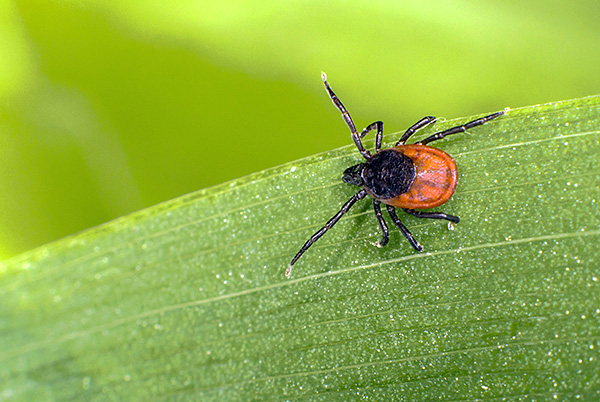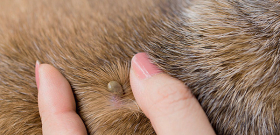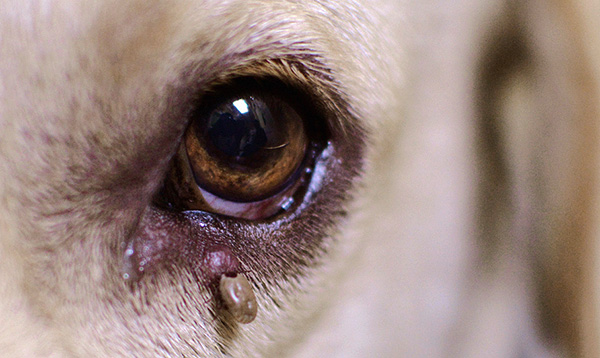
It is important for the owner of a dog that has been bitten by a tick (or is regularly bitten by ticks) to carefully monitor and be able to recognize in time the symptoms of diseases that a pet can become infected with from a parasite. A tick bite for a dog can indeed be very dangerous, and in some cases leads to serious consequences for the animal.
Some tick-borne infections develop so quickly that literally hours count from the moment the first symptoms appear: if the owner manages to bring the pet to the veterinarian during this time, then the dog's life can be saved. It won't work - alas...

On a note
Therefore, by the way, it is completely irresponsible to rely on the treatment of a dog at home after the appearance of obvious symptoms of a tick infection. Such diseases are not treated at home, and their therapy is possible only with the use of specialized tools. This is the only way to avoid serious consequences for the pet.
The situation is further complicated by the fact that a dog can become infected with a dangerous disease when bitten by a tick anywhere: in a city park, on a lawn in the yard of a private house, in a hunting field, in a forest. Here, even the region in which the bite occurred does not play a role: the most dangerous tick-borne infections are ubiquitous and do not have such geographical focality as, say, tick-borne encephalitis in humans.
At the same time, the parasite itself often goes unnoticed, especially in animals with long thick hair. And this means that you should be well aware of the signs of diseases that develop after tick bites, and respond correctly to them even when the parasite itself did not seem to be removed from the pet (it could drink blood and fall off unnoticed).
Let's see what diseases a dog can get from a tick, what symptoms signal the development of the corresponding pathologies, and what exactly the owner of the animal can do in case of a disease ...
What diseases can threaten a dog with a tick bite
Perhaps the most common and dangerous tick infection for dogs is piroplasmosis. It is caused by babesia, a protozoan parasite of the blood, which is why it is also called babesiosis. It is deadly for dogs of all ages, but puppies and young animals are most severely ill and more often fatal.

According to the rate of development of symptoms and the nature of the course, piroplasmosis is classified into several forms: chronic, acute and hyperacute.
The first leads to a long-term weakening of the dog's health, sometimes to the development of irreversible consequences of the disease, and a reduction in life expectancy. The acute form of piroplasmosis without treatment (or with improper treatment) usually ends in the death of the animal 5-7 days after the onset of the first symptoms, but with the correct therapy it can be cured without consequences.
The hyperacute form is usually manifested by the death of the dog without the development of preliminary symptoms, and only at post-mortem autopsy are piroplasms found in the blood of the animal.
On a note
In a hyperacute form, piroplasmosis rarely occurs in domestic dogs. More often this form is found in foxes.
Piroplasmosis is constantly expanding its range and today is diagnosed throughout Eurasia and North America. If until 1970-1980 it was mainly a “professional” disease of hunting dogs, which were infected with it from ticks in natural biotopes, then in the last few decades, piroplasmosis has been actively penetrating along with ticks into cities. Today, dogs often become infected with it in yards, parks and squares.

It is interesting
Piroplasmosis is a typical "canine" disease. Its main carriers are precisely domestic dogs, but in the wild other canines also get sick with it: foxes, wolves, jackals, raccoon dogs. Cats with piroplasmosis are extremely rare. Cattle are very susceptible to piroplasmosis, but there is still no consensus among scientists on the question of whether the same pathogen causes the disease in dogs and cattle, or the species of Babesia that specialize in different hosts differ. People do not get piroplasmosis.
Another common tick-borne disease in dogs is Lyme borreliosis. It also affects people, including, but it is impossible to catch it directly from a sick dog: the pathogen can only be transmitted borreliosis tick.
With borreliosis, almost any tissue of the body can be affected - from the brain to the joints, therefore, in chronic or acute form, borreliosis can manifest itself with a wide variety of symptoms. The disease is deadly for dogs, but relatively easy to treat with timely diagnosis and proper selection of drugs.
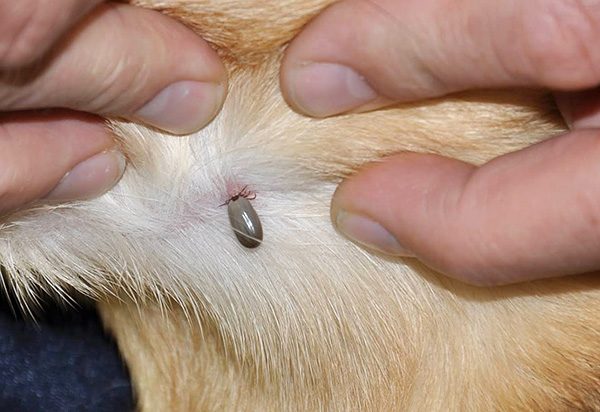
Among other tick-borne infections that are dangerous for dogs, it is worth highlighting the following:
- Spotted fever is a disease that is equally dangerous for both humans and animals.It is rare in Eurasia, more typical of the North American continent (it is also called Rocky Mountain spotted fever). Represents an insignificant epidemiological danger due to the fact that the transmission of the pathogen occurs only a few hours after the tick is sucked. Usually, before that, they already have time to detect and remove it. Animal and human deaths from spotted fever are rare and occur in the absence of diagnosis and treatment, or when the disease is detected too late;
- Hepatozoonosis is a disease caused by the protozoan Hepatozoon canis and transmitted mainly by eating ticks. Due to the lack of specific symptoms, hepatozoonosis is often confused with other diseases, which leads to a delay in proper treatment. The disease relatively rarely leads to death, severe consequences from infection usually develop either with a sharp weakening of the animal's immunity, or with the simultaneous development of another disease;
- Granulocytic ehrlichiosis, known mainly in the United States. Outside the North American continent, cases have been reported from the Nordic countries. It is equally dangerous for dogs, and for people, and for cattle (horses, cows, goats). However, deaths from ehrlichiosis are not known in dogs or humans;
- Bartonellosis is a specific disease of cats, relatively rarely transmitted to dogs and capable of leading to the death of an animal in its neglected form. The disease is common in the tropics; in Eurasia, only isolated cases of it were noted.
On a note
But dogs do not get tick-borne encephalitis.Nevertheless, piroplasmosis is approximately as dangerous for them as encephalitis for humans, and the causative agents of these diseases are carried by ticks of the same species (with a few exceptions).
In the photo below - dog tick (Ixodes ricinus), the most common carrier of tick-borne encephalitis and piroplasmosis in Europe and the European part of Russia:
Due to the partial intersection of the areas of tick-borne infections (for example, piroplasmosis and borreliosis occur in the same regions), it is often difficult to understand what specific disease a dog has. The uncertainty is compounded by the fact that the first symptoms of tick-borne infections are often similar.
First symptoms to watch out for
All diseases of dogs caused by tick-borne infections, at the end of the incubation period, are manifested by general non-specific symptoms. These include:
- High body temperature in the animal - above 40 ° C (at a rate of 39 ° C), dry nose, obvious signs of fever;
- Lethargy, unwillingness of the pet to move, walk;
- Shaky, unsteady gait;
- Heavy breathing, shortness of breath.
For piroplasmosis, the last symptom - heavy breathing - is more relevant than for other diseases. The fact is that with this disease, red blood cells that carry oxygen are destroyed. The tissues of the animal's body begin to experience hypoxia, the dog has to breathe more often and deeply in order to get more oxygen for each breath.
However, with the development of fever in other diseases, the animal's breathing also becomes deeper and heavier than usual.
On a note
It is interesting that dogs with an increased resistance of the immune system, or those who have previously had piroplasmosis, tolerate it in a milder form with a different symptom complex. They may not have a fever, but only lose their appetite and become less active.

Often, but not always, other symptoms may develop with piproplasmosis:
- Obvious weakness of the hind legs - the dog crouches on them, trying to walk;
- Diarrhea with blood clots;
- Vomiting, also with blood;
- Pale mucous membranes of the oral cavity.
A characteristic feature of piroplasmosis is the dark color of urine (it is also called the color of "meat slops" - brown, similar to the color of strong tea). However, it does not appear immediately after the end of the incubation period, but on the 2-3rd day of illness, when the dog is usually brought to the veterinarian and he manages to diagnose the disease.
With borreliosis in dogs, as in humans, there is an annular erythema migrans - ring-shaped redness around the bite site, gradually increasing in size and "spreading" to the sides.
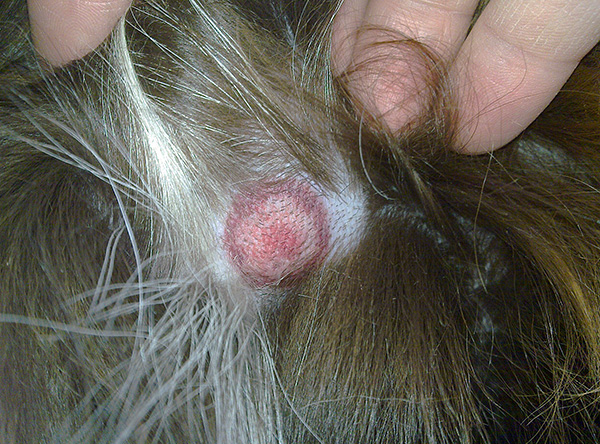
Spotted fever and hepatozoonosis rarely present with specific symptoms that are not found in other diseases. With them, the condition of the dog simply worsens, it becomes lethargic, her temperature rises and her appetite disappears. Actually, it is precisely because of this similarity of symptoms that the emergency diagnosis of diseases is difficult, and for an accurate diagnosis, at least a peripheral blood test is required.
By the tick itself or by the appearance of the bite, it is impossible to determine whether the dog was infected (with the exception of the appearance of erythema migrans on the skin, during the development of which one can first talk about borreliosis).

This cannot be done with the help of any analyzes carried out in the first days, before the mass destruction of the target tissues and cells by the pathogen. All that is required of the owner is to carefully monitor the condition of the pet and pay attention to any changes in his behavior.
Some veterinarians recommend taking your dog's temperature every day after a tick bite during the incubation period. Others believe that this measure is redundant, since when the temperature rises, the behavior of the pet changes accordingly (and quite noticeably).
Incubation period for tick-borne infections in dogs
For the main tick infections that dogs are susceptible to, the first symptoms appear on average 1-2 weeks after infection. With piroplasmosis, the incubation period usually lasts 10-18 days, with ehrlichiosis - 8-12, with hepatozoonosis - 10-14.
At the same time, the duration of the incubation period depends on the number of infectious agents transmitted to the dog by a bite, on the weight of the animal itself and on the general physical condition, including the state of the immune system.
On a note
For example, the incubation period of piroplasmosis in small domestic dogs of decorative breeds - Pekingese, Yorkshire terriers, dwarf dachshunds - can last 4-5 days, and in large shepherd dogs, the first signs of the disease can appear even 20 days after the bite.
In any case, the symptoms of a tick infection do not develop immediately. The bite of a tick does not immediately cause a deterioration in the condition of the animal by itself. If, for example, a bitten dog vomited an hour or two after the discovery of the parasite, then in most cases this is not related to the bite itself.
You also need to take into account the fact that an infected tick can bite a pet unnoticed by the owner. So, small nymphs are hardly noticeable in the thick wool of the same Yorkies, Pekingese, and even more so, Caucasian shepherd dogs or Labradors. And for any peculiarities of behavior it is almost impossible to understand that the dog has picked up a tick - the parasite bites painlessly and does not bother its victim. Consequently, after a bite, the dog may begin to develop a disease that will be a complete surprise for the owner - he has not seen a tick and does not expect that the pet can become infected.
For example, the photo below shows a small tick nymph, which would not be so easy to notice in thick wool, but which can also be a carrier of infections:
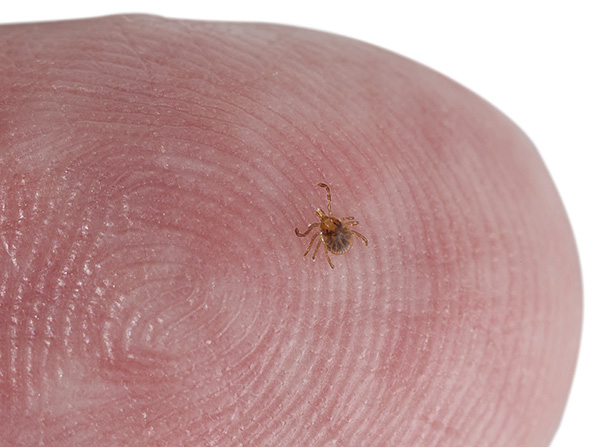
This means that in tick season (in Russia, Kazakhstan and in European countries - from April to October) you should carefully monitor the condition of pets, and immediately take action when the first symptoms of a tick infection appear. It sometimes depends on how quickly and how correctly the owner of the dog reacts to the signs of the disease, whether the animal will survive or not.
First aid for a pet
If a tick is found on a dog, it should be removed as soon as possible delete. The causative agents of diseases are transmitted to the animal precisely with the saliva of the parasite, and the tick secretes it in portions with long breaks - up to several hours between acts of bloodsucking. The faster the parasite is removed, the less saliva it will inject into the wound and the less risk of infection.
Once again, let's pay attention to the priorities: the speed of tick removal is more important than the correctness and technicality of this process.It is better to tear off the tick with your fingers immediately upon detection than to take the dog home for half an hour, to make a ticker from improvised means and then gently unscrew the tick for another ten minutes. Even if it happens that the proboscis of the parasite remains in the wound - this is not so important, it can be removed later, upon returning home.
On a note
In fairness, it is worth noting that with a simple detachment of a tick from the skin of a dog, its jaws remain extremely rare in the wound. The most common and numerous type of tick that bites canines in Europe and the European part of Russia - the dog tick - does not form a cementing case in the wound when bitten, and therefore its gnathosoma is weakly fixed in the skin, and when detached, it is easily pulled out of the wound.
If you have a special tick remover, then the parasite must be carefully unscrewed. If there is no device, you should try to unscrew the tick with your fingers (without pressing on its body). You can twist both clockwise and counterclockwise.
The photo below clearly shows that a large blood-sucking mite can be grasped with fingers with nails of sufficient length:
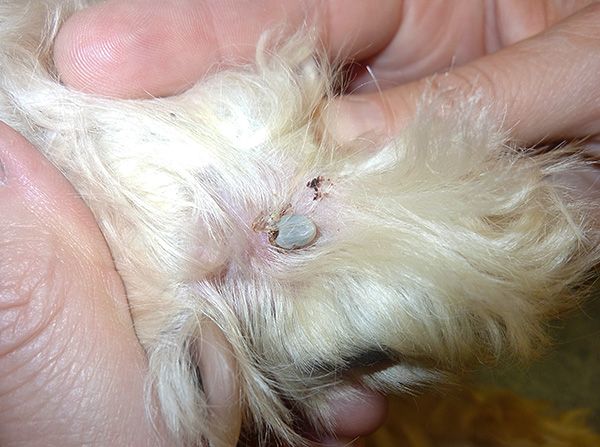
After detaching the parasite, it must be carefully examined: if the jaws protrude from the head in the form of a small needle, then everything is in order, and no parts of the parasite remain in the dog's skin. If the head of the tick is not visible, it means that it has remained in the wound. You need to try to remove it with a needle, nail tweezers or even a toothpick in the same way as a regular splinter is removed.
Then it is useful to examine the dog and try to find other ticks on it. If she caught one, then where she ran, these parasites live, and she could have picked up a few more. Especially carefully you need to examine the ears, neck, muzzle, armpits, groin, the spaces between the fingers. If other ticks are found, they are also removed.
As a rule, the dog does not pay attention to the bite wound. Sometimes the pet begins to comb the wound due to itching (the bump here can itch). In this case, it is useful to treat the trace of a tick bite with an anesthetic ointment - Trauma-gel, Levomekol, Traumex, Iruksovetin, etc.
If later an abscess, inflammation, weeping ulcer or dermatitis appears at the site of the bite, then the dog should be shown to the veterinarian.
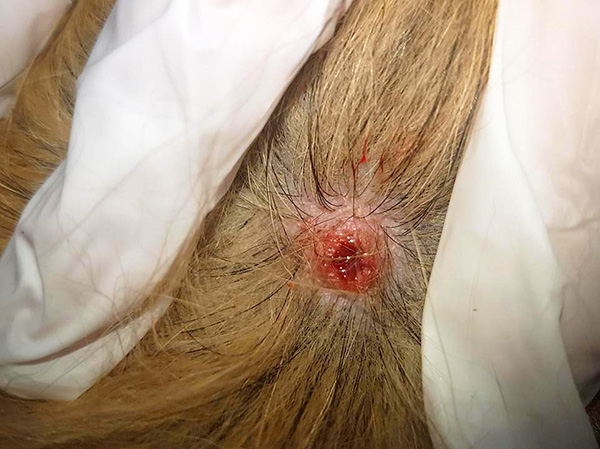
At the same time, do not overdo it and do unnecessary actions. It makes no sense to take your dog to the vet for treatment immediately after a tick bite. Also, you do not need to carry a tick for examination, because laboratories do not analyze the parasite for piroplasmosis. Finally, you do not need to prophylactically give your pet medication for piroplasmosis. These drugs are very toxic, and as a preventive measure without signs of the development of the disease, it is forbidden to use them.
The above measures of first aid are quite enough. After removing the tick, the need for further action arises only when symptoms of the disease appear. At the same time, the steps that the owner of the animal must take are relatively simple.
What to do when symptoms of the disease appear?
If during the season of tick activity, and even more so during the standard incubation period after a parasite bite, the dog has symptoms of the disease, it should be taken to the veterinarian as soon as possible.It is the specialist at this time who will be able to diagnose the disease, choose the tactics of treatment and the arsenal of the necessary means, and then carry out the therapy with maximum efficiency.
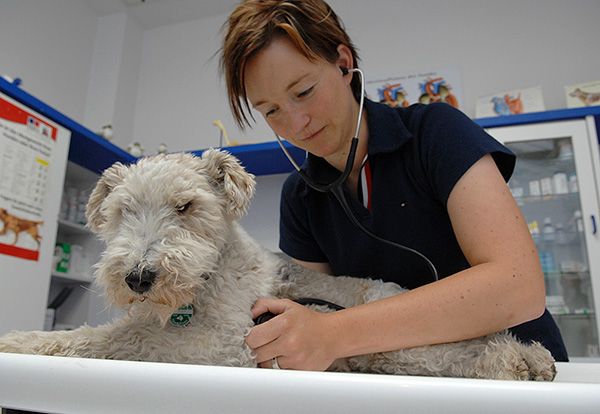
If the journey to the veterinarian requires more than 5 hours of driving, it is worth calling the doctor before the trip and find out what it is desirable to do right away. For certain symptoms, it makes sense to give the dog symptomatic treatment in order to alleviate his condition a little.
On a note
In exceptional cases, a one-time use of drugs for piroplasmosis is allowed if it is impossible to get to the veterinarian for one reason or another. For example, signs of illness develop in a dog living in a remote area, or at this time, circumstances do not allow taking the animal to the clinic. In this case, you need to call the doctor by phone and get instructions from him about what drugs and in what quantities to administer to the animal. As a rule, this is one of the main anti-babesion drugs - Berenil, Azidin, Veriben, or their analogues.
It is worth noting that in those areas where there are no veterinary clinics, it is usually not possible to quickly buy such medicines, so you should take care of their availability in advance.
Diagnosis and treatment of piroplasmosis in the clinic
In the optimal case, the dog, after the onset of symptoms of piroplasmosis, is taken to the clinic, where the doctor takes her blood for analysis. Babesia are found in the blood under a microscope, on the basis of which the doctor makes an appropriate diagnosis.
Below, in a photograph taken with a microscope, babesias are clearly visible in blood cells:
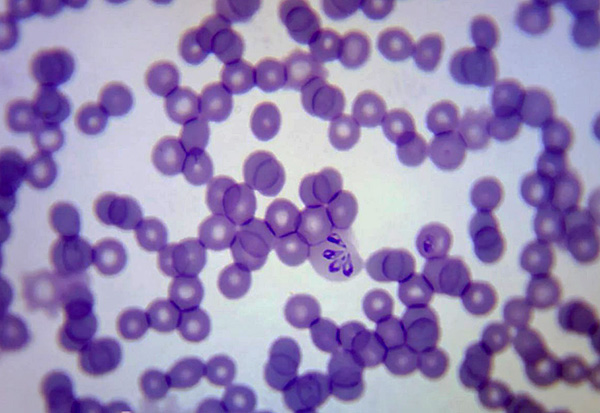
As a rule, blood is taken from the ear, since the presence of babesia is most easily determined in peripheral blood.Analysis of venous blood for piroplasmosis is uninformative. The procedure for taking blood is somewhat painful, but in most cases, dogs tolerate it calmly due to general apathy and weakness.
Immediately after the detection of babesia in the blood, the dog is injected with an etiotropic drug that allows you to quickly destroy these particular parasites. All drugs for the treatment of piroplasmosis are administered in amounts corresponding to the body weight of the animal. They are very toxic, often cause severe side effects, and therefore their overdose is unacceptable. This is partly why they are highly undesirable for use by anyone other than a professional veterinarian.
Additionally, the doctor may administer to the dog means for symptomatic treatment - anti-inflammatory, respiratory stimulants, diuretics (to detoxify the body), and others. They alleviate the condition of the animal, relieve symptoms and speed up recovery. In some cases, severely weakened dogs are given a drip to supply the body with nutrients.
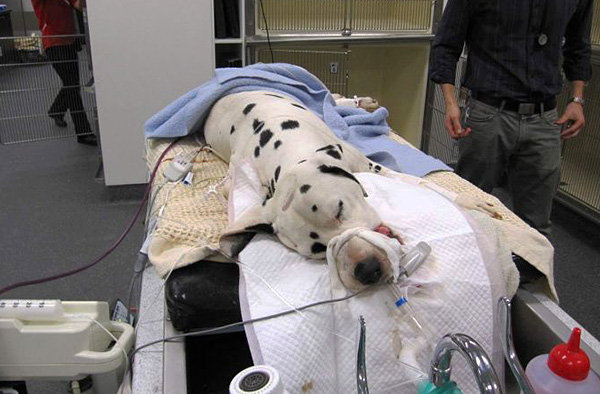
Treatment is carried out in the clinic until the start of obvious improvements in the condition of the animal. When the condition is normalized, the owners take the pet home and use the medicines prescribed by the doctor until the end of the treatment. The veterinarian recommends nutrition during this rehabilitation period, focusing on the individual characteristics of the dog.
If the dog is not treated, then on the 5-7th day of the disease in an acute form, the temperature of the animal drops below physiologically normal, paralysis of the hind limbs occurs and then death. In the chronic form, piroplasmosis can end in complete recovery at different times - from 3 to 12 weeks.
Treatment of other diseases
Other tick-borne infections are also diagnosed with a blood test.It either finds specific parasites (for example, with ehrlichiosis), or reveals changes in the composition of the blood, characteristic of the same hepatozoonosis or spotted fever.
Borreliosis and ehrlichiosis are treated with tetracycline antibiotics, and relatively simple and affordable - tetracycline or doxycycline; borreliosis is also successfully treated with penicillin (amoxicillin, ampicillin) and cephalosporin antibiotics (ceftriaxone, cefotaxime).
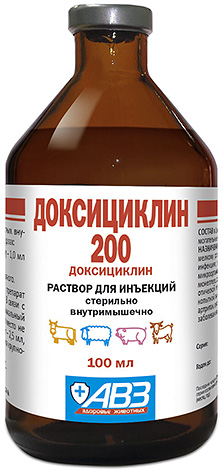
Usually, the very next day after the first injection of the drug, the dog's condition noticeably improves, the temperature returns to normal, and after 2-3 days the pet recovers almost completely.
Hepatozoonosis is more difficult to treat. It is believed that no modern tool provides complete elimination of the pathogen from the body. To a certain extent, antibiotics, which are used in conjunction with anti-inflammatory drugs, allow relief from the condition of the animal. However, even with correct treatment, 2-3 months after the initial exacerbation, a relapse may occur, requiring repeated therapy. As a rule, a dog with hepatozoonosis can live up to a year with proper treatment, but it is difficult to achieve a full recovery.
How to Reduce Your Dog's Risk of Infection from a Tick Bite
With all the danger and breadth of distribution of piroplasmosis and borreliosis, there are no means of specific prevention of these diseases. Vaccinations against piroplasmosis (for example, Pirostop, Pirodog) are ineffective, quite expensive and somewhat dangerous for dogs, so the expediency of their use is refuted by many veterinarians, but is mainly welcomed by manufacturers and sellers of the vaccines themselves.

Non-specific prevention measures are more accessible and safe, but also do not provide absolutely reliable pet protection. These tools and methods include:
- Drops on the withers from ticks and fleas. Parasites do not bite a dog correctly and in a timely manner treated with such drops;
- Collars and repellent sprays. The first ones are put on the neck of the dogs, the second ones are sprayed with their coat just before going outside;
- Thorough examinations of the dog after walking during the season of tick activity, combing and quick removal of parasites found;
- Changing the place of walking the dog after the detection of ticks on it.
Various overalls and clothes for dogs practically do not protect against tick bites.
In conclusion, it is worth noting once again that during the period of activity of ticks, the owner of the dog needs to be very attentive to its condition, even if, in fact, the tick on the animal has never been found. With the timely detection of symptoms of tick-borne infections and the correct response to them, in most cases, the pet can be cured completely and without serious consequences for his health.
If you have personal experience in treating a dog after a tick bite, be sure to share the information by leaving your review at the bottom of this page.
What is important for a dog owner to know about piroplasmosis

